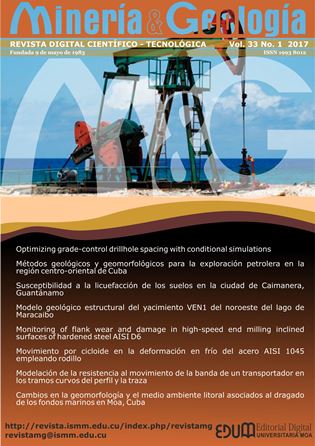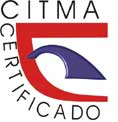Espaciamiento óptimo de sondajes de control de leyes usando simulación condicional (EN INGLÉS)
Palabras clave:
espaciamiento de sondaje, simulación condicional, control de leyes.Resumen
El artículo muestra un método para determinar el espaciamiento óptimo de sondajes de control de leyes perforados con circulación inversa. Como criterio de espaciamiento óptimo se tomó aquel cuyo costo iguala el costo de clasificar erróneamente de unidades de selectividad minera (SMU, siglas en inglés) en mena y estéril. El costo del error de clasificación, para un determinado espaciamiento entre sondajes, es igual al costo de procesar estéril erróneamente clasificado como mena (error Tipo I) más el valor de la mena clasificada erróneamente como estéril (error Tipo II). Los errores de Tipo I y II se dedujeron comparando los valores reales y estimados de las leyes en las SMU, en relación con una ley de corte determinada y asumiendo selección libre de las SMU mineralizadas. Los valores reales de las leyes en las SMU y en intervalos de muestreo de los sondajes se generaron con simulaciones condicionales. Los valores estimados en las SMU, uno para cada espaciamiento entre sondaje, se obtuvieron estimando con krigeage ordinario. El método propuesto fue usado para determinar el espaciamiento óptimo entre sondajes de un yacimiento de oro. Los resultados mostraron que el costo de clasificación errónea puede ser afectado por valores extremos en las SMU y tienden a ser sobrevalorados. Se propone usar topes en el valor del error de clasificación en las SMU y descartar las SMU no minables con el objetivo de reducir la sobreevaluación del valor total del error de clasificación.Descargas
Citas
BERTOLI, O.; PAUL, A.; CASLEY, Z. & DUNN, D. 2013: Geostatistical drillhole spacing analysis for coal resource classification in the Bowen Basin, Queensland. International Journal of Coal Geology 112: 107–113.
BOUCHER, A.; DIMITRAKOPOULOS, R. & VARGAS-GUZMÁN, J. A. 2005: Joint Simulations, Optimal Drillhole Spacing and the Role of the Stockpile. In: Geostatistics Banff 2004 [online]. Dordrecht: Springer Netherlands. p. 35–44. [Accessed 16 November 2016].
CHILÈS, J. P. & DELFINER, P. 2009: Geostatistics: Modeling Spatial Uncertainty [online]. Wiley. Wiley Series in Probability and Statistics.
GORIA, S.; GALLI, A. & ARMSTRONG, M. 2001: Quantifying the impact of additional drilling on an openpit gold project. In: 2001 annual conference of the International Association for Mathematical Geology. Cancun, Mexico.
JOURNEL, A. G. & KYRIAKIDIS, P. C. 2004: Evaluation of Mineral Reserves: A Simulation Approach. Oxford University Press. Applied Geostatistics.
LARRONDO, P. 2003: Entropy of Gaussian Random Functions and Consequences in Geostatistics [online]. Department of Civil & Environmental Engineering University of Alberta. CCG Annual Report. Available in: http://www.ccgalberta.com/ccgresources/report05/2003-129-entropy.pdf
MARTÍNEZ-VARGAS, A. 2016: PyGSLIB [online]. Python 2.7 package. Opengeostat Consulting. Available in: https://github.com/opengeostat/pygslib
VERLY, G.; POSTOLSKI, T. & PARKER, H. M. 2014: Assessing Uncertainty with Drill Hole Spacing Studies–Applications to Mineral Resources. In: Orebody Modelling and Strategic Mine Planning Symposium 2014. Australasian Institute of Mining and Metallurgy. Perth, Australia, 24-26 November.
Publicado
Cómo citar
Número
Sección
Derechos de autor 2017 Adrian Martínez-Vargas

Esta obra está bajo una licencia internacional Creative Commons Atribución-NoComercial 4.0.
Los autores que publican en esta revista están de acuerdo con los siguientes términos:
- Licencia Creative Commons Atribución-NoComercial permite que el beneficiario de la licencia tenga el derecho de copiar, distribuir, exhibir y representar la obra y hacer obras derivadas para fines no comerciales siempre y cuando reconozca y cite la obra de la forma especificada por el autor o el licenciante.
- Los autores pueden establecer por separado acuerdos adicionales para la distribución no exclusiva de la versión de la obra publicada en la revista (por ejemplo, situarlo en un repositorio institucional o publicarlo en un libro), con un reconocimiento de su publicación inicial en esta revista.
- Se permite y se anima a los autores a difundir sus trabajos electrónicamente (por ejemplo, en repositorios institucionales o en su propio sitio web) antes y durante el proceso de envío, ya que puede dar lugar a intercambios productivos, así como a una citación más temprana y mayor de los trabajos publicados (Véase The Effect of Open Access) (en inglés).
- Lo anterior debe realizarse siempre sobre el artículo ya publicado por Minería y Geología.
La revista permite que los autores tengan los derechos de autor sin restricciones
La revista permite que los autores conserven los derechos de publicación sin restricciones










